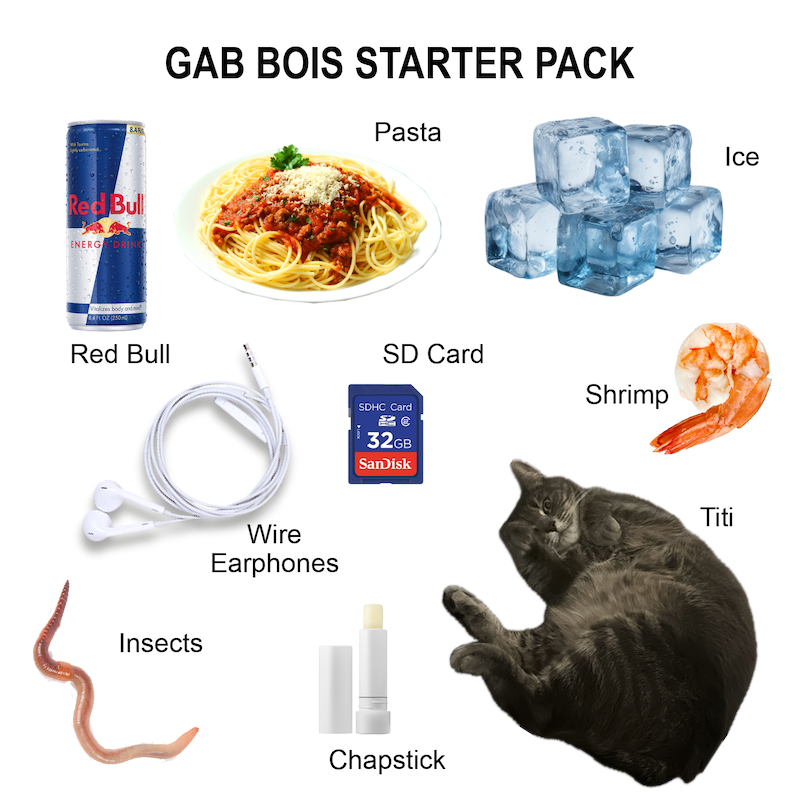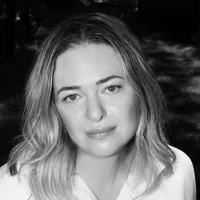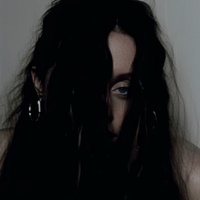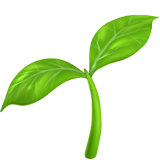On making what you want
Prelude
Gab bois is interested in revealing the surreal quality of everyday objects, notably food, technology and fashion. Influenced by childhood experiences of playing pretend, she brings a distinct element of fantasy to her body of bizarre tableaux and whimsical props. Her work is a place where the double entendre of hyperrealism and the commonness of the familiar object happily coexist. With a practice focusing on photography, video direction and object design, Bois’s versatility is tied together by a distinct thread of recurring themes and subjects, from self-representation in the selfie era to the humor of the mundane. Self-taught on all fronts, Bois’ curiosity and passion for bringing concepts to reality is what keeps her practice ever-evolving.
Conversation
On making what you want
Artist Gab bois discusses executing wild ideas, not feeling famous despite having 700,000 followers, and how her parents made art feel accessible.
As told to Yang Shi, 1452 words.
Tags: Art, Photography, Video, Collaboration, Beginnings, Business, Process, Family.
Gab, how are you?
I’m good! We’ve been busier than ever, but all good things. A lot of exciting projects in the works. Honestly, the last couple of years have been wild in the best way. We’ve grown the team, pushed into new mediums outside of photo and video, and added a more physical side to my practice.
I see that—there’s furniture, sculptures, even food in your studio right now. Anything else you’ve worked on that was fun?
Yeah! I’ve always had a thing for objects and materials, but we also worked with dogs recently, for a calendar, which was cool. It was a different challenge working with live, non-human subjects, and just rolling with the dog’s mood that day.



You’re an Instagram sensation—I think you’re probably the most internet-famous person I know. A lot of people know your work, but they don’t necessarily know you. What is it like to be famous?
That’s funny because it doesn’t feel that way. I’m just living my life. That’s always been my mindset: I make what I want, and if people connect, great. But I also have the benefit of being relatively faceless. I show my face sometimes, but my platform is so global that I don’t really get recognized locally. It’s an audience of around 700,000 people, but they’re spread across the world—mostly digitally. So it doesn’t really translate to real life, which I actually appreciate.
How has having a wide global audience changed your practice?
It’s shaped some of the partnerships we get, for sure. It’s opened up opportunities I wouldn’t have had otherwise. But in terms of how we work—me, my team—it hasn’t changed. We still go off intuition and personal taste. That’s always been the core.
When I first met you, you were a one-woman show. Now you have a team. What’s that like, and why did you build one?
It’s been great. I hired my first studio assistant a little over three years ago, and from there, it just grew. Everyone has different roles. Some tasks are daily, and others are more fluid. We have a thoughtful, complementary team where everyone knows what they bring to the creative vision.
It’s more collaborative now. I still lead the creative—that’s the essence of my practice—but the execution is a bigger conversation. We work with a huge network of vendors because so many of our ideas require specialized skills or materials. That collaboration is key to bringing things to life. Never in a million years would I be able to do the scope of what I do today if it wasn’t for my team.
Your work transforms the everyday into something unexpected. What drives your fascination with re-contextualizing objects? What’s your creative process like?
It all comes from childhood. I was an only child, always making things with my hands. What I do now is just an extension of what I loved doing as a kid. It’s a blessing—every day is fun. As for the process, it’s hard to define because it changes. If we’re working on commissions, one week we might be doing a photo series, and the next producing an event. It’s fluid; we start with the idea and work backward, troubleshooting how to bring it to life.
Do you do sketches or mockups?
Depends on the project. Some don’t need them, but others do, especially if we need 3D renders or have to involve architects or engineers for safety. It’s all about the end goal. If it’s an installation, it’s technical. If it’s just a photo for Instagram, it’s a whole different approach.

When you hit a creative block, how do you get through it? Do you have any rituals?
Honestly, I don’t think I’ve ever hit one. I have slower moments, but it’s usually about my environment. If my mind is overloaded, I won’t have space for ideas. But I don’t see that as a rut. I know how to fix it: I just step away. As long as I have enough space and quiet, the ideas always come.
So you never get bored.
Never. I never got bored as a kid, and I don’t now. My parents always told me, “You never asked for a sibling. You were always playing, by yourself or with kids on our street.” My mind moves fast and I need constant stimulation. Even at home, I can’t sit still. I’ll think, “Oh, I could clean this cabinet or rearrange my photo wall.” There’s always something.
I read that your dad was a painter. How did that shape your creative process?
My dad was a receptionist for most of his professional life—he’s retired now—but he loved painting. It wasn’t a career, just a passion. That made art feel accessible to me. My parents helped with that, too. They took me to museums and let me go at my own pace. If I wanted to skip something, fine. If I didn’t understand something, no big deal. They gave me audio guides so I could follow along. It never felt intimidating.
Do you remember the first piece of art that hit you?
Yeah, super vividly. It was a painting of strawberries by Renoir. It was super textured, and something about it just hit me. It was at the art museum in Quebec City. I was 13, way too cool to cry over a painting, but I teared up. I have no idea why, but it stuck with me. I bought the postcard of that particular painting at the museum gift shop after going through the exhibit as a way to hold on to that moment.



What are your inspirations outside of art?
I draw a lot of inspiration from objects, especially things that make you do a double take. It could be an unexpected design detail, a surreal landscape, someone’s haircut, or even the way something moves. I love anything that challenges perception or feels slightly off in a way that makes you look twice. Beyond art and design, my boyfriend is an actor, and he’s really expanded my perspective on cinema and theatre. He’s introduced me to films I wouldn’t have sought out on my own, and it’s been incredible to explore storytelling from that angle. Lately, a few cultural moments that have really excited me include The Substance, Tyler, the Creator’s Chromakopia, and Matthieu Blazy’s appointment as Chanel’s creative director.
You constantly push creative boundaries. Have you ever surprised yourself with a project?
Definitely. There are always moments where an idea just clicks, sometimes even more than I expected. One example is the lasagna hair bow. Initially, it was meant to be just a fun closing image in a carousel of other pasta-related photos. But when I saw the final result, it completely exceeded my expectations. It looked so much better than I had imagined and, ironically, ended up being one of my most successful posts online. The best part isn’t just having an idea but seeing it come to life. When the result matches or exceeds what I imagined, that’s the best. But it happens just as often in the opposite direction, which keeps things interesting. What’s so cool about this is it doesn’t exist until we make it.



Gab bois studio photos by Yang Shi
Okay, fun question: if you had to give up one sense for a year, which would it be?
Smell. Easy.
But you need smell to taste!
True… But I’m not giving up sight, touch, or hearing. So yeah, smell.
If you had to create a piece of art using only hospital items, what would you do?
Funny you ask—I was at the dentist recently, and I kept thinking about how medical trays and tools feel like food trays and utensils. I’d probably play with that parallel.
What’s next for you?
So much. We have a bunch of new products coming out, plus some really exciting brand partnerships. I also want to direct more video work. We’ve been dabbling in it, but I want this to be a big video year.

- Name
- Gab bois
- Vocation
- artist
Some Things
Pagination



